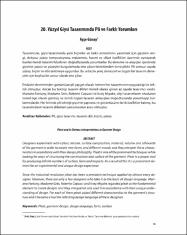| dc.contributor.author | Günay, Ayşe | en_US |
| dc.date.accessioned | 2023-01-20T02:19:25Z | |
| dc.date.available | 2023-01-20T02:19:25Z | |
| dc.date.issued | 2015-12-01 | |
| dc.identifier.citation | Günay, A. (2015). 20. Yüzyıl giysi tasarımında Pli ve farklı yorumları. İstanbul Aydın Üniversitesi Güzel Sanatlar Fakültesi Dergisi, 1(2), 13-23. | en_US |
| dc.identifier.issn | 2149-3960 | |
| dc.identifier.uri | https://hdl.handle.net/11729/5260 | |
| dc.identifier.uri | https://dergipark.org.tr/tr/pub/aydinsanat/issue/31794/348600 | |
| dc.description.abstract | Tasarımcılar, giysi tasarımında yeni biçimler ve farklı atmosferler yaratmak için giysinin rengi, dokusu, yüzey kompozisyonu, malzemesi, hacmi ve silüet özellikleri üzerinde oynayarak bunları kendi tasarım felsefeleri doğrultusunda yorumlarlar. Bu deneme ve arayışlar içerisinde giysinin yapısı ve yüzeyini kurgulamada öne çıkan tekniklerden birisi plidir. Pli sonsuz sayıda yüzey, biçim ve etki üretmeye uygundur. Bu sebeple yeni, deneysel ve özgün bir tasarım deneyimi için başlıca bir unsur olarak öne çıkar. Endüstri devriminden günümüze pli yaygın olarak hemen her tasarımcının uyguladığı bir teknik olmuştur. Ancak bu tekniği tasarım dilinin temeli olarak gören az sayıda tasarımcı vardır. Mariano Fortuny, Madame Grès, Roberto Capucci ve İssey Miyake, pliyi tasarımlarını oluşturan temel öge olarak görmüş ve kendi özgün tasarım anlayışları doğrultusunda yorumlayıp kullanmışlardır. Her birinde pli tekniği giysinin yapısına ve görüntüsüne farklı özellikler katmış, bu tasarımcıların tasarım dillerinin yansımasının aracı olmuştur. | en_US |
| dc.description.abstract | Designers experiment with colour, texture, surface composition, material, volume and silhouette of the garment in order to create new forms and different moods and they interpret these characteristics in accordance with their design philosophy. Pleat is one of the prominent techniques while looking for ways of structuring the construction and surface of the garment. Pleat is a proper tool for producing infinite numbers of surface, form and impacts. As a result of this it is a prominent element for an experimental and unique design experience. Since the industrial revolution pleat has been a prevalent technique applied by almost every designer. However, there are only a few designers who take it as the basis of design language. Mariano Fortuny, Madame Grès, Roberto Capucci and Issey Miyake regarded pleat as the fundamental element to create designs and they interpreted and used it in accordance with their unique understanding of design. For each of them pleat added different characteristics to the garment’s structure and it became a tool for reflecting design language of these designers. | en_US |
| dc.language.iso | tur | en_US |
| dc.publisher | İstanbul Aydın Üniversitesi | en_US |
| dc.rights | info:eu-repo/semantics/openAccess | en_US |
| dc.subject | Pli | en_US |
| dc.subject | Giysi tasarımı | en_US |
| dc.subject | Tasarım dili | en_US |
| dc.subject | Biçim | en_US |
| dc.subject | Yüzey | en_US |
| dc.subject | Pleat | en_US |
| dc.subject | Garment design | en_US |
| dc.subject | Design language | en_US |
| dc.subject | Form | en_US |
| dc.subject | Surface | en_US |
| dc.title | 20. Yüzyıl giysi tasarımında Pli ve farklı yorumları | en_US |
| dc.title.alternative | Pleat and its various interpretations in garment design | en_US |
| dc.type | article | en_US |
| dc.description.version | Publisher's Version | en_US |
| dc.relation.journal | İstanbul Aydın Üniversitesi Güzel Sanatlar Fakültesi Dergisi | en_US |
| dc.contributor.department | Işık Üniversitesi, Güzel Sanatlar Fakültesi, Moda ve Tekstil Tasarımı Bölümü | en_US |
| dc.contributor.department | Işık University, Faculty of Fine Arts, Department of Fashion and Textile Design | en_US |
| dc.identifier.volume | 1 | |
| dc.identifier.issue | 2 | |
| dc.identifier.startpage | 13 | |
| dc.identifier.endpage | 23 | |
| dc.peerreviewed | Yes | en_US |
| dc.publicationstatus | Published | en_US |
| dc.relation.publicationcategory | Makale - Ulusal Hakemli Dergi - Kurum Öğretim Elemanı | en_US |
| dc.contributor.institutionauthor | Günay, Ayşe | en_US |


















